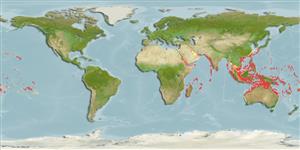Common names from other countries
Environment: milieu / climate zone / depth range / distribution range
Ecologia
marinhas associadas(os) a recifes; intervalo de profundidade 3 - 60 m (Ref. 1602), usually 5 - 50 m (Ref. 27115). Tropical; 24°C - 28°C (Ref. 27115); 32°N - 35°S, 24°E - 132°W
Indo-Pacific: Red Sea and East Africa to Samoa and the Tuamoto Islands, north to southern Japan.
Tamanho / Peso / Idade
Maturity: Lm ? range ? - ? cm
Max length : 22.0 cm TL macho/indeterminado; (Ref. 4392)
Espinhos dorsais (total): 9; Raios dorsais (total): 11-13; Espinhos anais 3; Raios anais : 11 - 13. Ground color of female very dark brown; orangish on front of head and lower parts; body spotted with white or very pale yellow, extending to dorsal and anal fins; caudal bright cadmium. Male form deep violet; irregular blue spots on cheeks and lower operculum; body with round blue spots becoming oblong, nearly forming longitudinal bands ventrally; dorsal and anal fins with longitudinal bands; caudal with numerous blue ocelli. Dorsal spines flexible. Caudal fin of adults truncate to emarginate; rounded in small juveniles. Easily confused with male A. geographicus when seen underwater, except when displaying with iridescent blue-green lines and spots over the body and fins (Ref. 48636).
Adults are found in areas of mixed coral, rubble, consolidated limestone, and sand of seaward reefs; also in soft coral or sponge habitats (Ref. 48636). Oviparous, distinct pairing during breeding (Ref. 205). Minimum depth reported taken from Ref. 30874.
Ciclo de vida ou comportamento de acasalamento
Maturidade | Reprodução | Desova | Ovos | Fecundidade | Larvas
Oviparous, distinct pairing during breeding (Ref. 205).
Randall, J.E., 1972. A revision of the labrid fish genus Anampses. Micronesica 8(1-2):151-190. (Ref. 2677)
Status na Lista Vermelha da UICN (Ref. 130435)
CITES (Ref. 128078)
Not Evaluated
Ameaça para os humanos
Harmless
Uso pelos humanos
Pescarias: pouco comercial; Aquário: Espécies comerciais
Mais informação
ReferênciasAquaculturaPerfil para aquaculturaEstirpesGenéticaElectrophoresesHereditariedadeDoençasProcessamentoConversão de massa
Ferramentas
Relatórios especiais
Baixar XML
Fontes da internet
Estimates based on models
Preferred temperature (Ref.
115969): 24.3 - 29, mean 27.6 (based on 1474 cells).
Índice de diversidade filogenética (Ref.
82804): PD
50 = 0.5002 [Uniqueness, from 0.5 = low to 2.0 = high].
Bayesian length-weight: a=0.00977 (0.00470 - 0.02030), b=3.07 (2.89 - 3.25), in cm Total Length, based on LWR estimates for this (Sub)family-body shape (Ref.
93245).
Nível Trófico (Ref.
69278): 3.5 ±0.37 se; based on food items.
Resiliência (Ref.
120179): médio(a), tempo mínimo de duplicação da população 1,4 - 4,4 anos (Preliminary K or Fecundity.).
Fishing Vulnerability (Ref.
59153): Low vulnerability (12 of 100).
